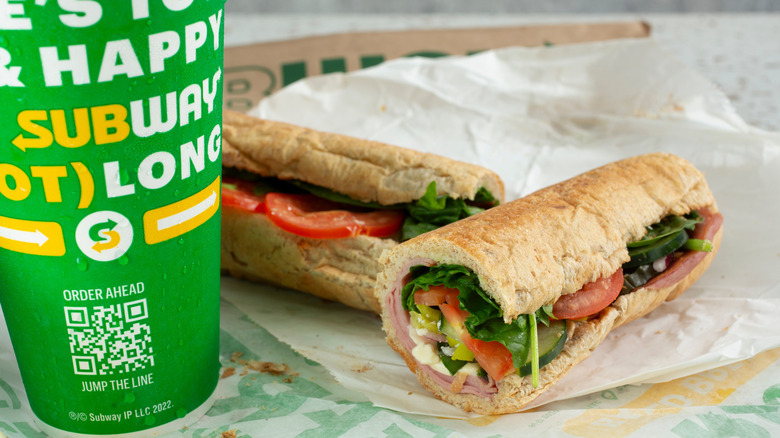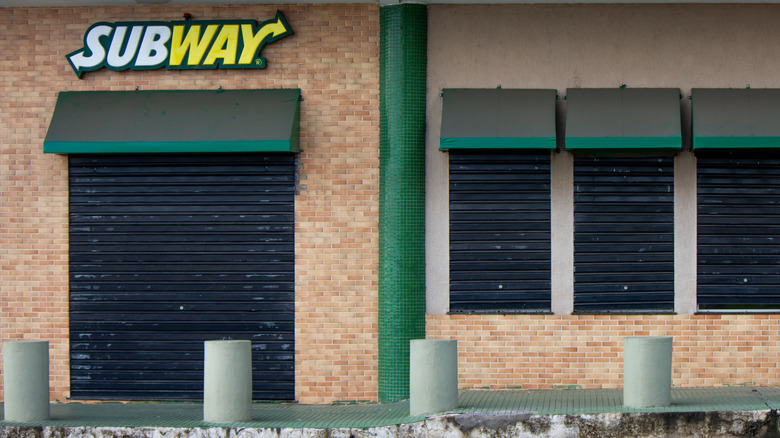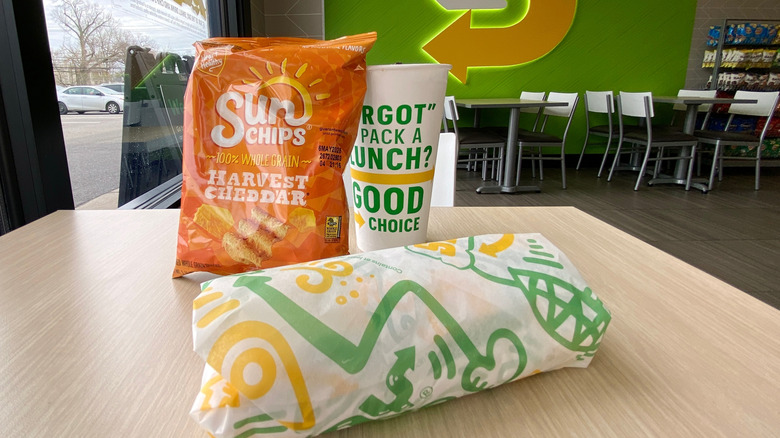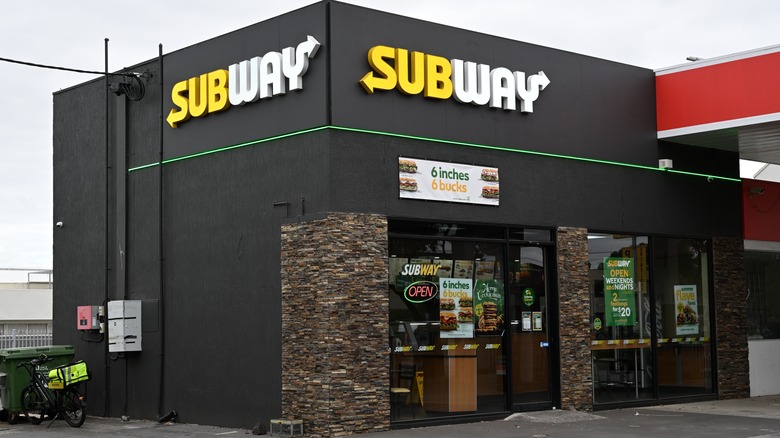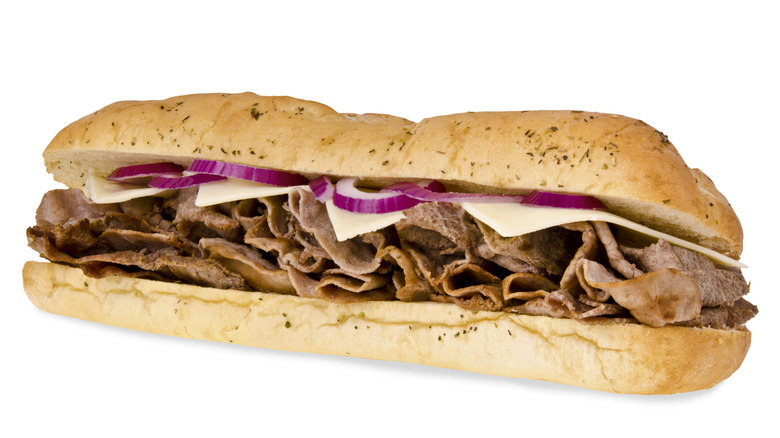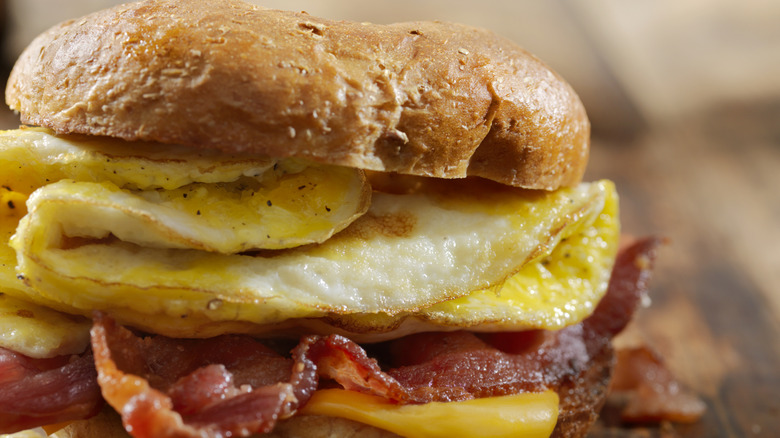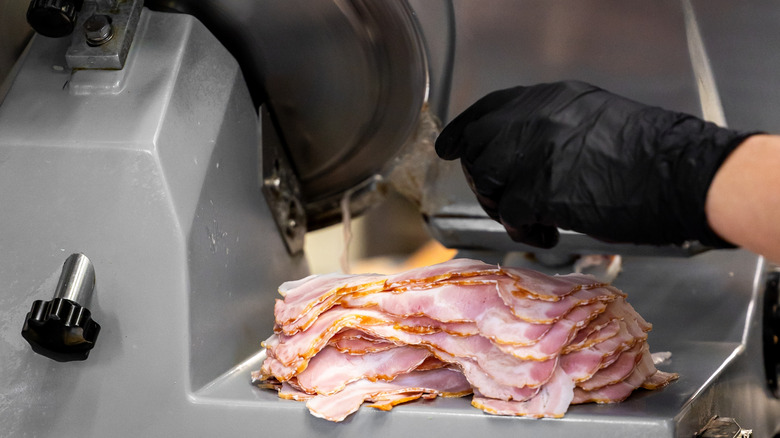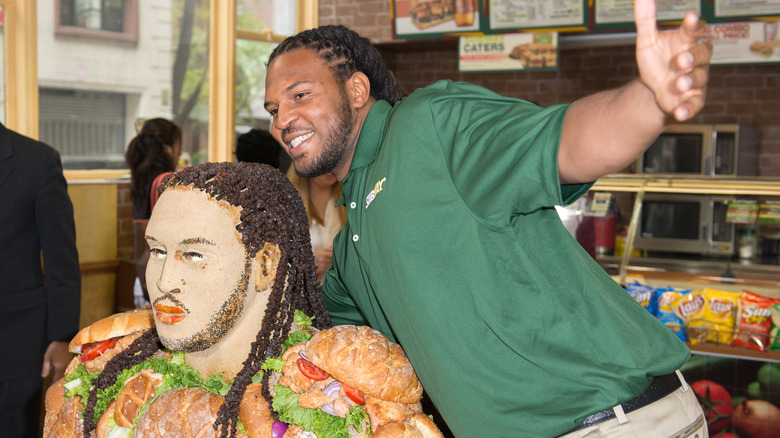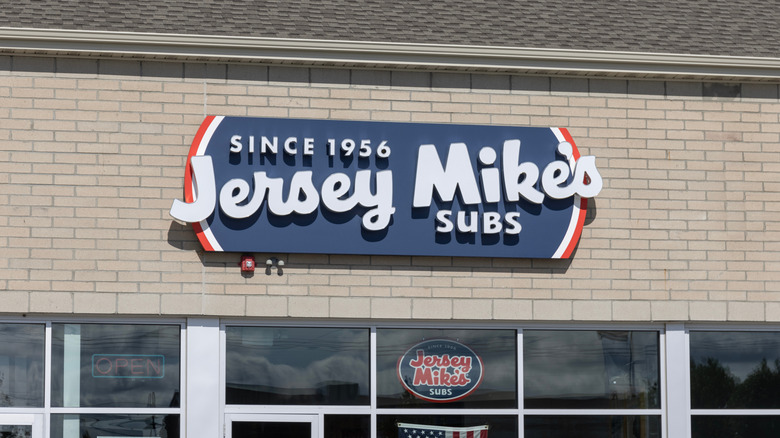10 Signs Subway Is Struggling
Subway may have once been king of the footlongs, but these days the decades-old sandwich chain is struggling to keep its place at the table. In an era where diners crave fresh concepts and fast casual flair, Subway has fallen behind and is starting to show its age.
It's a far cry from the brand's humble beginnings. The chain started as a money-making idea from 17-year-old Fred DeLuca, who opened his first sub sandwich shop — Pete's Super Submarine — in Bridgeport, Connecticut, in 1965 and used the money to pay for college. That first shop was named after his investor, Peter Buck, who put up $1,000 to get the sandwich shop idea underway, and sold sandwiches for less than a dollar. After growing to 16 locations less than 10 years later, the founder and his investment partner chose to franchise, at which point the Subway brand was born and quickly became a household name.
But the good times didn't last. Things started to slip in 2014 when sales declined by 3%, and competition from then-rivals such as McDonald's, Panera Bread, Jimmy John's, and Potbelly began to pick up. Like other restaurants and fast food chains, the pandemic stalled recovery for the chain with few drive-thrus and a weakening brand. Add in some public relations stumbles, unhappy franchisees, and intensifying competition, and Subway's path forward looks anything but clear. So, what went wrong, and can it be fixed? Here are 10 signs Subway is struggling to hold onto its place in the sandwich world.
There's a steady trend of Subway closing restaurants
Back in the early 2000s, it felt like you couldn't go a block without spotting a Subway, sort of like the explosive growth of Starbucks. These days, if you're craving a 6-inch Cold Cut Combo, you may have to pull up Google Maps to track down your nearest location. Subway has been steadily shrinking, closing more stores than it opened for nine consecutive years. In 2024 alone, the sandwich chain shuttered more than 600 locations, having closed over 7,000 over the course of nine years. The chain currently has just under 20,000 stores, compared to its peak of 27,000 in 2015. Its largest round of closures was in 2020 (aka the peak of the COVID-19 pandemic) when it lost 1,601 restaurants.
Its chips may be in its international growth, with 10,000 new locations opened or planned in the last three years. Counting its global units, Subway is the third-largest restaurant chain in the world, behind McDonald's and Starbucks. However, its closing trend may continue. In response to questions about the chain's shrinkage, a Subway spokesperson in May told CNN that it would continue to evaluate its U.S. presence "using a strategic, data-driven approach to ensure restaurants are in the right location, image and format and operated by the right franchisees."
Subway has sold out to private equity
In August 2023, Subway was sold to private equity firm Roark Capital for over $9.5 billion. No stranger to U.S. fast food brands, Roark's portfolio also includes Dave's Hot Chicken, Dunkin', Jimmy John's, Moe's, and Arby's. The mega sale of Subway not only marked a potential reinvigoration for the brand, but it also officially ended its era as a family-owned and operated business.
The teen founder, Fred DeLuca, who later became president, and his investor, Peter Buck, kept a tight grip on the company for decades. Even after their deaths, ownership remained within their families, who seemed more interested in protecting the brand's legacy and profits than evolving with the times. That changed in 2019 when John Chidsey took over as the first non-family member to lead Subway — a clear signal that something had to give. With sales sliding and the brand losing relevance, Chidsey was brought in as an effort to turn things around for the chain. He moved quickly, pushing long overdue changes like expanding digital sales and tapping into growth areas like catering.
While the results weren't a dramatic turnaround, they were enough to position the brand as attractive to investors and convince the DeLuca and Buck families it was time to step aside. While the families initially slapped a $10 billion price tag on Subway, Roark's offer came in close, giving them a handsome payday and closing the book on nearly six decades of family control.
Subway has experienced turnover in the C-suite
John Chidsey, who took over as CEO of Subway in 2019, worked feverishly on a turnaround plan to not only reposition the chain as the top sandwich shop but to net the highest dollars from a private equity sale. The sale may have been the most significant part of Chidsey's legacy at Subway, but it wasn't the only one. Chidsey was responsible for Subway's Eat Fresh Refresh campaign, which overhauled the chain's menu, introduced premium ingredients and new recipes, and rolled out new sandwiches, including the All-American Club and the Cali Fresh Sub. While Chidsey pledged to stay at the company after the sale, the chain announced in November 2024 that he would be exiting at the end of the year.
About the same time Chidsey joined, Subway named Carrie Walsh its global chief marketing officer (CMO). She then stepped into the position of president of Europe, Middle East, and Africa (EMEA) before being made interim CEO while a search for a permanent CEO was conducted. The changes in Subway's C-suite didn't stop there. Walsh's CMO role had been vacant since she shifted to EMEA president in 2023 until Greg Lyons, a former PepsiCo marketing chief, was tapped for the role in early 2025. Days later, another departure rattled the leadership team when Doug Fry, president of Subway's North America operations, announced his exit after less than two years in the role. Unrest among the top brass often signals challenges internally, so all eyes are on what's next for the world's most-watched sandwich chain.
Subway has abandoned several promotions ahead of schedule
The days of $5 footlongs are definitely behind us, but Subway has since tried to recapture the magic with other value deals, many of which ended abruptly after not meeting expectations. In June 2020, the chain launched a two-for-$10 footlong deal. As it was rolled out to franchisees, Subway believed the value deal would bring more customers through the doors and generate more sales of drinks, chips, and cookies. Franchisees argued that it's tough to make a profit on $5 subs amid rising labor and food costs. Subway quietly revised the offer after just two weeks, limiting it only to digital customers.
It was a similar situation when Subway launched a $6.99 meal deal at the end of 2024, offering customers a 6-inch sub, a small fountain drink, and either chips or two regular cookies. Launched in November 2024 as a limited offer, it was supposed to run through the end of December. Once again, it only survived a few weeks before the chain limited it to digital customers, citing poor performance.
Whether this was a flop or an example of a business wisely accepting that it's better to fail fast and move on is up for debate. The statement from the chain over this premature promotion cancellation suggests that Subway prefers to think of it as the latter. "We continuously test new value platforms aimed at helping drive profitable traffic and encouraging repeat visits," it told Restaurant Business Online. "We take feedback and data seriously, and if needed, we quickly adjust course to ensure we're doing what's best for our franchisees, guests, and overall business."
Not all franchisees are satisfied
Subway's growth from a single store to the largest global sandwich chain wasn't exactly smooth sailing. After nearly a decade of slow growth, in 1974, co-owners Fred DeLuca and Peter Buck brought in DeLuca's friend, Brian Dixon, as its first franchisee with a location in Wallingford, Connecticut. By the 1980s, opening a Subway franchise required a franchise fee of $15,000, plus startup costs, fueling rapid expansion from inside gas stations off busy interstates to strip malls in suburbia.
But tensions between franchisees and Subway have long simmered. Subway doesn't own any of its restaurants, and takes an 8% share of gross royalties from franchisees. Over the last four years, there's been a lot of unrest between the chain and restaurant operators who claimed that locations were popping up too close to each other and protesting excessive fees, including a mandate last year to remodel their stores or risk being kicked out of the Subway family. Franchisees have also notoriously disliked promotional deals, claiming that they hurt their bottom line, like the $6.99 footlong deal in 2024 that deeply discounted a sandwich that normally sells for $11 to $17.
Subway's menu and portions have come under scrutiny
The drifting loyalty of budget-conscious sandwich fans hasn't made it any easier for Subway to recover from its struggles. Even those with a love-hate relationship with the distinct yeasty, herby aroma that greets you upon entering a Subway haven't held back from criticizing everything from new menu items and skimpy portions to its prices.
Some customers even filed a lawsuit against the sandwich chain in October 2024, accusing it of misleading customers over how much meat it packs (or doesn't pack) into a Steak & Cheese sub. With photo evidence, the suit claimed that Subway deceives customers with advertising that doesn't match the actual portions sold to customers. Portion sizes and soaring prices go hand in hand as a point of contention with customers, with many taking to social media to complain about their purchases. As one former fan put it on Reddit, "Quality was always dubious, but it managed to barely scrape by in the price-quality ratio curve. Now they are charging for them as if they were real subs and not the instant-put-together-slob with week-old ingredients."
Fans were equally critical of the chain's collaborations with Doritos and Oreo in 2025, claiming the new footlong treats were underwhelming in both taste and value at $5 plus tax. When new promotions receive more critique than hype from fans, the struggling brand is put in a precarious spot.
Employees have snubbed Subway's breakfast
Customers aren't the only ones side-eyeing Subway these days. Some employees are chiming in, too, further intensifying speculation that the once-beloved chain might be slipping. For example, employees say you should think twice before ordering breakfast at Subway, and research into what exactly is in some of the chain's breakfast items reaffirms the warning.
Back in 2010, Subway entered the fast food breakfast scene, debuting a slew of breakfast sandwiches served on English muffins, flatbreads, or 6-inch or footlong sub rolls. At the time, Subway leaned into its market position as a healthier fast food alternative, promoting its breakfast items as lighter and lower in fat. But by 2018, Subway lifted its requirements for all franchisees to serve breakfast, spurring speculation that breakfast sales didn't soar.
There were more red flags from employees and customers alike. The quality and freshness of eggs, a main ingredient for all of Subway's breakfast items, have been questioned. These egg patties are frozen, often served cold, and may contain additives as thickening agents or flavor enhancers, including xanthan gum, cellulose gum, and citric acid. Employees have even taken to TikTok to warn Subway fans of the lackluster breakfast experience, alleging that the eggs and sausages aren't always fresh.
Investment in meat slicers flopped
When consumers started questioning the freshness of the chain's deli meat and competitors like Jimmy John's, Firehouse Subs, and Jersey Mike's began gaining ground, Subway announced that it wouldn't use pre-sliced meat anymore. While this sounds like it should be a positive change and well-paired with the brand's Eat Fresh Refresh campaign, it actually didn't go over so well.
Pre-sliced meat actually saves restaurants money and time. Getting a whole cut of meat is cheaper than pre-sliced, and the process of getting deli meat from the chunk to a sandwich is a bit laborious, requiring proper slicing and sanitizing, slowing down the sandwich-making line. Needless to say, when Subway put $6,000 meat slicers in 20,000 locations in 2023, the rollout landed flat. Many franchisees saw it as a burden, not a gift. Complaints ranged from increased waste to higher labor costs due to the time required for operating and cleaning the equipment, leading others to lament that the new deli slicers could only do so much for Subway. Plus, despite lauding the investment as elevating the menu, it didn't lead to higher sandwich sales or profits.
Subway was replaced by rival for NFL sponsorship
The pairing of footlongs and football came to an end in early 2025, causing many to wonder if the chain has just sliced its marketing budget amid hard times. Subway spent five years as the official NFL sponsor, enjoying exclusive marketing rights at key NFL events and experiences, as well as sponsoring NFL FLAG, the U.S. flag football league, and NFL PLAY 60, the organization's youth-focused initiative. The NFL sponsorship also led to a new menu lineup of NFL player-inspired sandwiches, including Trevor Lawrence's The Sunshine Sub, featuring oven-roasted turkey with fresh mozzarella, avocado, and tomatoes on multigrain bread. For non-football fans, Lawrence is a quarterback for the Jacksonville Jaguars, with his sub likely drawing inspiration from Florida's status as the Sunshine State.
Subway was replaced as an NFL sponsor by Jersey Mike's beginning with the 2025 season. It's not clear what Subway paid to be the NFL sponsor, as, being a private company, it's not required to publicize its financial spending. However, it's likely a sizable chunk of change, meaning Subway is almost certainly saving a significant amount by letting Jersey Mike's take over the slot.
Subway has fallen in rankings of sandwich chains
Subway may still be the biggest sandwich chain in terms of sheer quantity, but it's seemingly losing favor in the eyes of the public. The chain has slipped in several rankings of our favorite sub shops, beaten out by competitors such as Jimmy John's, Jersey Mike's, and Firehouse Subs, as well as smaller, lesser-known chains, such as Mendocino Farms, Which Wich, and PrimoHoagies.
Even in broader fast food rankings, Subway's standing is shaky. In 2024, for the third consecutive year, Subway continued to cling to its position in America's fast food ranking, holding steady at No. 8. Over a decade earlier, however, it ranked second, just below McDonald's. Between 2019 and 2024, Jersey Mike's gobbled up 7% more of the market, while Subway continued to shrink, losing 4% market share over that same period. With rapid expansion plans and a growing fanbase, Jersey Mike's isn't just catching up; it's taking a big bite out of Subway's sandwich dominance.
